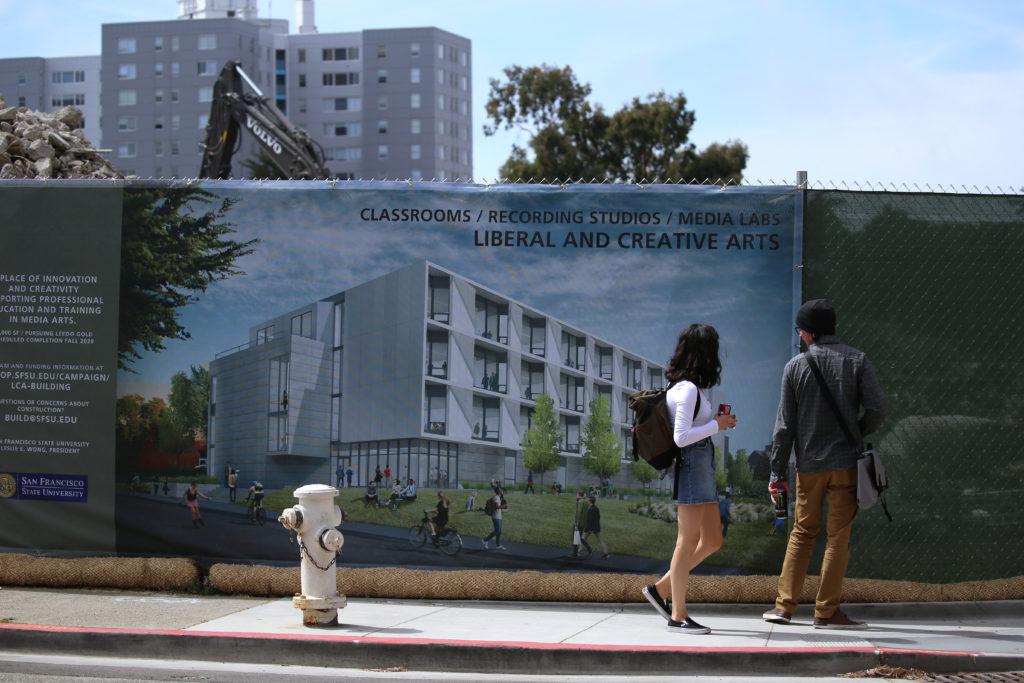University Enterprises presented a draft proposal at the Dec. 3 Public Forum on the Campus Master Plan meeting that sketched out development and land management at SF State through 2035 and aims to draw in 5,000 new students and create 9,000 new beds through the renovation of existing buildings, better land management and new student housing.

Jason Porth, vice president of University Enterprises and executive director of University Corporation, made a 25-minute presentation that covered topics such as housing, a hotel proposal, future enrollment goals, and academic and recreational expansion.
Porth, however, made it clear that the master plan was a grandiose vision unlikely to ever be fully realized.
He noted that the 2007 master plan, which was intended to last through 2020, has fulfilled only two of the nearly 30 buildings and renovations proposed: the Mashouf Wellness Center and a new Liberal and Creative Arts Building.
“It is an aspiration,” Porth said. “It is our best guess at the time with the information that we have of what we think we can deliver…and that’s because we don’t have the funding.”
The plan comes ahead of anticipated student body growth and declining structural soundness in a number of buildings. The anticipated rise in student enrollment led to a debate on whether campus expansion or housing should come first.
An email sent to Brandon Kline, SF State associate director for environmental programs, criticizes the plan as exacerbating the problems caused by the soaring Bay Area housing costs.
The email was sent by Oumani (no last name provided), a member of a group called SF Unite.
“By SFSU pursuing their 2035 new campus expansion plan, it is stating clearly that it no longer wants to support its historic purpose, educating the next workforce coming from and for the Bay Area,” the email read.
Kline told Xpress that the group’s concerns would be taken into consideration as the university continues to map out the campus’ future.
University Enterprises’ plan is said to factor in environmental awareness that goes beyond global warming. It aims to address concerns from transportation impacts to air quality and other implications the development may have for nearby residents.
Feedback from the six colleges on campus led the university to conclude that the first challenge to be addressed should be the impact of the Bay Area’s continued dramatic growth. The region’s skyrocketing population has caused rents to reach new highs, according to Bay Area market reports, and University Enterprises argues this has led to a decline in graduation rates.
“We had a waiting list of about 3,000 students who’d like to live in SF State but can’t because we don’t have enough places for them to live on campus,” Porth said.
He argued the university’s low graduation rate, just 20 percent, is a function of unmanageable rent prices, some more than $3,500 per month. He believes students drop out of SF State and seek alternative education rather than pay to live near the university.
“They ended up moving home or making a different decision about how they’re going to get their education,” he said.
University Enterprises intends to increase class availability by addressing the low graduation rate, and they believe the best strategy is to create more physical space for new classes.
They proposed renovating many existing buildings while demolishing and replacing others.
SF State spends and receives $6 million a year addressing deferred maintenance problems, according to University Corporation, and with their proposal they hope to avoid pouring money into short-term fixes.
While CSU provides $3 million of the funds needed for campus maintenance, the rest comes out of the university’s own coffers, and by proxy, the pockets of students.
The university predicts that over the coming decade, these costs will soar to nearly $1 billion.
If the goals presented in University Corporation’s proposal come to fruition, SF State would see full-time enrollment grow from 25,000 to 30,000.
If the proposal is approved, it would set the university back about $100 million, and that burden would not be picked up by the state or CSU system.
“Hopefully there’s a big benefactor in the room,” Porth said. “The housing has to be self-supportive.”
The university is seeking the approval of the CSU Board of Trustees for its proposition by November of 2019. And with a portion of SF State students experiencing some degree of homelessness, the proposal presents an opportunity to address the housing shortage so prevalent in the Bay Area.







